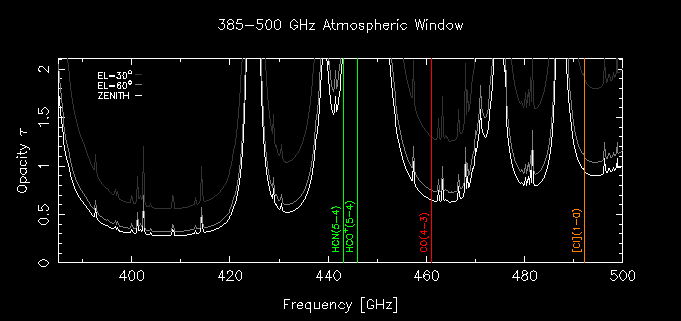Instrumentation Overview
ASTE Band 8 (ALMA Band 8 Qualification Model)
June 21, 2016
A cartridge-type dual-polarization side-band separating (2SB) mixer receiver operating at 387-498 GHz, developed as the ALMA Band 8 qualification model, is available from 2015.
Specifications
- Tunable LO frequency range: 393 GHz to 492 GHz
- IF frequency range: 4.0 GHz to 8.0 GHz
- Observable frequency range (LO frequency range +/- IF center frequency): 387 GHz to 498 GHz. Please consult us in advance if you want to observe a line beyond the frequency range.
- Receiver temperature


Figure 1: Receiver temperature as a function of LO frequency
- Image rejection ratio (IRR): 15 dB typical.


Figure 2: Image rejection ratio as a function of LO frequency
- Polarization: two linear polarizations(P0 and P1), but polization observations are not available.
- Expected system noise temperature (Tsys): 600-1000 K. It can be highly variable depending on the atmospheric conditions and observing frequency. See also Figure 1.
| Mixer | Npolar#1 | Npix | fLO (GHz) | fobs (GHz) | IF (GHz) | IRR | TRX (SSB) (K) | Tsys (SSB) (K)#2 |
|---|---|---|---|---|---|---|---|---|
| sideband-separating SIS mixer | 2 | 1 | 393-492 | 387-498 | 4.0-8.0 | 15 dB | 150-400 | 600-1000 |
- Note #1: ASTE Band 8 divides into two linear polarization by using a wire grid, not an orthomode transducer (OMT). Pointing difference between both P0 and P1 caused by the wire grid will be expected within 1.1 arcsec on average.
- Note #2: The system noise can be highly variable depending on the atmospheric conditions and observing frequency.
Receiver tuning
It requires about 10 minutes for receiver tuning when you start observations or change your observing frequency. Attenuators for LO and IF powers and room temperature absorber will be adjusted remotely by observers.

Figure 3: Current atmospheric opacity as a function of frequency. The figure is from the ASTE Sky Monitor.
